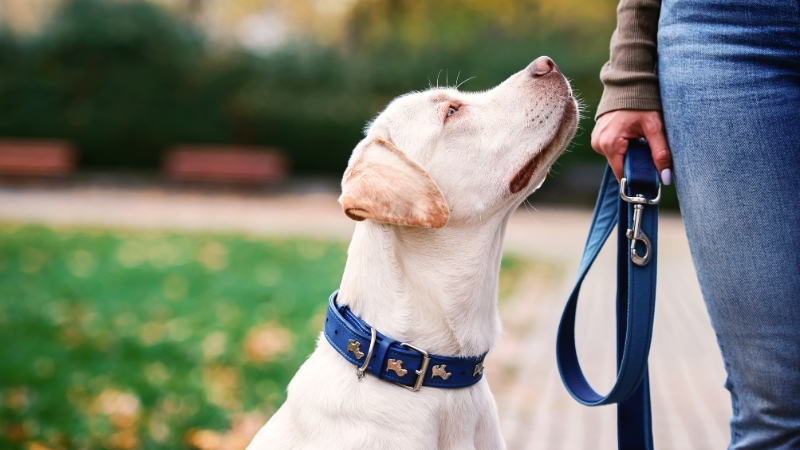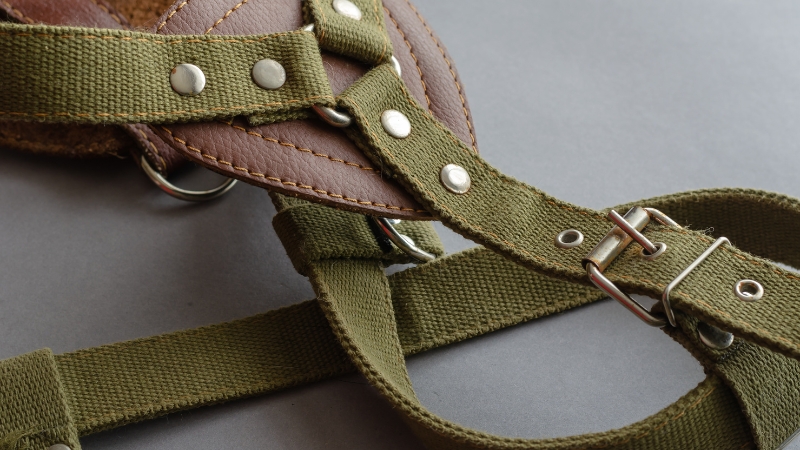Choosing between a harness and a collar for your dog may seem like a simple task, but many pet owners face confusion once they learn the real impact of both tools. Trainers and veterinarians point out that the right choice often depends on the dog’s breed, age, health, and behavior.
Every walk becomes safer and more effective when the proper option supports the specific needs. Instead of guessing, experts recommend taking a closer look at how each option functions.
Collars have long been associated with control and identification. However, they often place direct pressure on the neck, which can create problems, especially for dogs with respiratory concerns. You should pay attention to the breed of your pet.
A harness for English bulldog provides a safer solution that avoids neck stress and allows greater chest support. That breed’s body structure benefits more from a tool that redistributes force away from the throat area and allows comfort through the shoulders.
Harnesses work best for many other breeds as well, especially when pulling becomes an issue. Collars still serve a purpose in low-stress situations, such as carrying ID tags during short outings.
Each option carries its own advantages, but misusing either can lead to discomfort or risk. This article explains the key differences, practical guidance from professionals, and smart ways to choose based on your dog’s real needs.
Table of Contents
ToggleWhy You Must Have Proper Walking Gear

Walking tools are not accessories. They are critical pieces of gear that directly influence your dog’s health, behavior, and safety. Poor gear causes strain, confusion, and even fear during walks. Proper gear encourages control, comfort, and trust between the dog and the handler.
Dogs need different tools depending on how they move, how they respond to pressure, and what kind of training they receive. A dog that pulls will react differently to a collar compared to a harness. One puts pressure on the throat, the other spreads it across the chest. That difference matters with every single walk.
Owners often overlook the effect gear has on posture, breathing, and learning. Collars may appear easier, but many dogs benefit more from harnesses because of how they distribute force.
Which One Is Better and When to Use Each
– Dog has short snout or breathing issue – Dog is anxious, injured, or recovering – Walk happens in busy, loud, or crowded area – Handler needs more control – Training is in progress – Poorly fitted or unadjusted harness causes rubbing or shifting – Walk is short and in a quiet area – Dog has no health or respiratory issues – Used only for holding ID tags – Dog has sensitive airway or short skull – Walk involves traffic, crowds, or distractions
Tool
Use When
Avoid When
Harness
– Dog pulls or lunges
– None, unless dog shows strong fear response to wearing it
Collar
– Dog already walks calmly
– Dog pulls or reacts on leash
Main Differences Between Harness and Collar
- Harnesses reduce strain on the neck and shift pressure to the chest and shoulders
- Collars place all pressure on the throat, which can lead to trachea damage if the dog pulls
- Harnesses are harder to escape for most breeds and offer more secure contact points
- Collars allow quick attachment and identification, often with fewer straps and faster access
Practical Situations
- Use a harness during longer walks, training sessions, or with breeds that pull or lunge
- Use a collar only when the dog walks calmly, or during supervised activities
- In cities, harnesses offer safer support due to sudden movements, distractions, or traffic
- For quick outings or potty breaks, collars may offer convenience without compromising safety
Risk and Comfort Comparison
Dogs with sensitive airways or short snouts such as Pugs and Bulldogs face greater risk with collars. The pressure against the neck can worsen existing conditions.
Harnesses reduce this danger and give owners better physical control, especially with wide-chested breeds. Comfort also increases since harnesses do not tug at the same spot with every movement.
Health and Safety Advice from Vets

Veterinarians stress one rule above all else. Never apply pressure to a vulnerable area.
Breeds with short skulls or compressed nasal passages, such as Pugs, French Bulldogs, or Boston Terriers, face constant airway restriction. A collar increases that risk every time they pull or jerk forward.
Neck compression also affects toy breeds with delicate bone structure. In Chihuahuas and Yorkies, even brief leash pressure can trigger long-term tracheal collapse.
Harnesses remove that risk by shifting all force away from the throat and placing it on the chest.
Injury Patterns Seen in Daily Practice
Many clinics see repeated cases linked to long-term collar use. The most common include:
Age, Recovery, and Special Cases
Senior dogs cannot absorb force the same way as younger ones do. Their joints carry more stress, and their reflexes slow down.
A collar that worked in the early years often becomes unsafe later. Recovery from strain takes longer and can involve medications, therapy, or even surgery. Harnesses help reduce those risks, especially when chosen early in life.
Trainer Tips for Behavior and Control
View this post on Instagram
A post shared by Yorkshire Canine Academy – Dog Training (@yorkshire_canine_academy)
Certified trainers focus on reflex, repetition, and leash management. Their goal is not to restrain the dog but to teach clear signals. That requires tools that support correction without fear.
- Front-clip harness to change direction: When the dog surges ahead, the front clip rotates the chest toward you. That shift stops forward momentum without force.
- Hard stop for every pull: Take one step. If the leash tightens, freeze. Wait for slack before moving. Dogs learn pace by cause and pause.
- Sudden turns with no warning: At any moment, turn left or right without sound. The dog starts watching your hips and follows direction without tension.
- Short leash, soft slack: Keep the leash close to your leg but loose. Avoid a constant pull. Tension creates resistance. Slack creates cooperation.
- Neutral tone over shouting: Dogs follow patterns, not volume. Raise tone for energy. Lower it for calm. Stay neutral when correcting.
- End walk with routine: Come home. Sit. Remove harness. Wait five seconds. That end structure helps settle adrenaline. The next walk begins easier.
Size Affects Pressure Points
Small dogs cannot absorb force the same way large dogs can. A collar on a five-pound dog becomes a noose under pressure.
Large dogs overpower collars through mass and momentum. Harnesses remove that danger for both ends of the spectrum.
Breeds That Often Require a Harness
The Bottom Line
@dovecotedogs Collar vs harness? This is a debate that has been around for years and will be around in years to come. For me, the issue is not the equipment. The issue is the fact that the dog is pulling. This is what will put pressure on sensitive areas. If you would like to learn how to stop your dog from pulling on the lead, then head over to our online academy for a full video course. Head to: dovecotedogs.uscreen.io #dachshundsoftiktok #sausagedog #dachshund #dog #fyp #daxie #doxie #dogtraining #dogtrainer ♬ original sound – Jack
Your dog does not care about looks or brands. Your dog cares about how it feels to breathe, move, and respond during every walk.
A collar may work in calm, predictable moments. A harness offers safer control, better posture, and reduced risk in real-world settings.
Vets protect your dog’s body. Trainers shape your dog’s behavior. Both agree that gear must match the dog, not the human habit. A flat collar may hold tags, but a harness reduces force, discomfort, and confusion.
Do not treat this as a style choice. Treat it as health gear. You are choosing between pressure on the throat or freedom in the chest. Your dog depends on your decision every time that leash clicks into place. Make it the right one.
Related Posts:
- Top 5 Long-Bodied Dog Breeds for Apartment Living
- Buc-ee’s Hours and Menu Prices for 2024 - Everything…
- What to Improve First in Your Business if You Want…
- 10 Celebrity Interior Trends You’ll Want to Try at…
- 18 Types of Ladybugs Which You Should Know About
- 5 Most Common Lizards Found in Florida - All You…
















